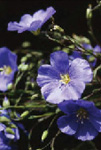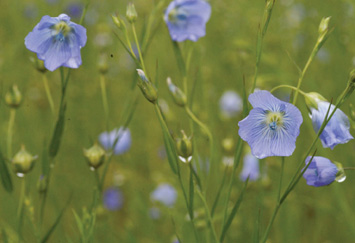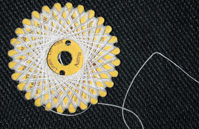

Closeup of flax flowers in November, near Solay, Ethiopia.
FLAX WAS THE MOST IMPORTANT plant fiber in Bible times. It was the source of linen, and cloth was made either from linen or wool. While its production has declined in recent years because of the superiority of cotton, a softer fiber more readily handled by machines, flax remains one of the most important fiber plants in the world because of the long, strong fibers found in the outer layers of the stem.
In processing, the outer layers of the stem are removed by a kind of controlled decay called “retting.” Retting in drier climates is accomplished by allowing the cut stalks of flax to remain out in the dew until the fiber-containing layers separate from the stem. This is probably why Rahab had bundles of flax on her roof: “But she had brought them [the spies] up to the roof and hidden them with the stalks of flax, which she had laid in order on the roof” (Joshua 2:6, NKJV). After retting, the fibers are cleaned and then bleached in the sun. Then the fibers are separated and woven into wicks or cords or spun into cloth. The linen produced in Egypt was especially fine: “And workers in flax will be in despair, and the carders and those at the loom will grow pale. Its weavers will be dismayed, and all who work for wages will be grieved” (Isaiah 19:9–10, ASV).
The scientific name of flax is Linum usitatissimum. The term usitatissimum means “most useful,” a suitable appellation for a plant used for both food and fiber. Flax is sown in the winter in the Middle East and flowers in the late spring. With sky-blue flowers that open only in the morning, flax is among the most beautiful of all crops when flowering; it is often planted as an ornamental.

Traditional flax culture in November, Oromia State, Ethiopia. This flax is grown for the seeds, which are an important food source. One way flax is eaten is to roast the seeds, then grind them and mix with milk.

Linen is derived from the stem of the flax. The long, strong flax fibers are made into linen.
Linen had several uses in Bible times. The primary use was for clothing, but in cord form it was also used as wicks and measuring lines: “A bruised reed shall he not break, And smoking flax shall he not quench, Till he send forth judgment unto victory” (Matthew 12:20, ASV, based on Isaiah 42:3); and, “He had a flax cord and a measuring rod in his hand and was standing in the gateway” (Ezekiel 40:3b, NJB). The English word “line” is from the Latin word for flax, linum. Words such as linear and lineage also derive from the same linguistic root.
One use of flax that is not mentioned in the Bible is culinary. Flax seeds are among the oldest known foods, and are often found with barley and wheat in archaeological sites throughout the Middle East (Zohary and Hopf 2000). Linseed oil is expressed from the seeds of flax.
In many years working in the Middle East, I have never seen flax growing, which is remarkable since it evolved in this region (Zohary and Hopf 2000). I learned that flax is not well known among local farmers, in an experience at the regional office of agriculture of the Palestinian National Authority in Tubas (the ancient Thebez of the Bible), a region of intensive farming. One of my former students was the local agricultural officer. He asked me to try to identify some seeds recovered by police from a man arrested and incarcerated on charges of growing a drug plant. The seeds were flax! While a host of compounds are present in flax, many that are beneficial for health, no narcotics have been identified (Oomah 2001).